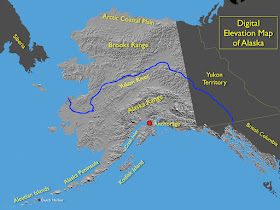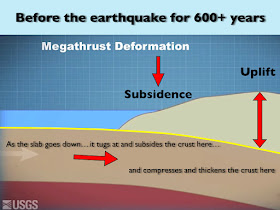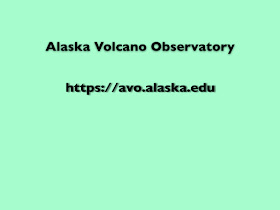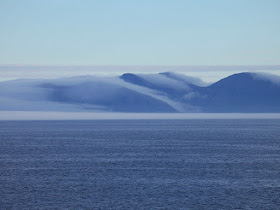I am back on board The World, perhaps the most unique ship that sails the Seven Seas. I am here to give geology lectures and drive Zodiacs as we cruise this amazing, tectonically active terrane.
I have already given one lecture entitled, "Fiery Bridge of the North: The Geology of the Alaska Peninsula and the Aleutian Islands." I include some slides from that lecture here, as well as some fabulous photos of the volcanoes we sailed past on August 5 in the Cook Inlet after leaving Anchorage.
Slides from my lecture: "Fiery Bridge of the North: The Geology of the Alaska Peninsula and the Aleutian Islands"
Letting people know what the subject is about. The Colosseo lecture Hal is phenomenal and has been updated since the last time I was here. Images are projected on a center screen from an overhead projector and on two TV monitors left and right of that. All lectures are streamed into the apartments and videos of each lecture becomes archived on board and are instantly retrievable for no less than three years.
I used this annotated Digital Elevation Map (DEM) to introduce listeners to the geography and landforms of Alaska. By pressing the advance key, the individual names of features appear as I talk about them. The two mountain ranges shown, the Alaska Range and the Brooks Range, determine the course of the Yukon River as it makes its way from the interior to the coast.
A colorized DEM shows the Aleutian volcanic arc and the 25,000 foot deep Aleutian trench. The Pacific Ocean floor is being consumed under the arc as it moves to the northwest (toward the upper left) into the trench. When that slab arrives about 60 miles deep, it is the right temperature to begin melting and blobs of magma move upward to create the volcano arc.
Don't be confused by the spelling of the word "terrane' above. While the more common spelling "terrain" refers to the shape of the land or a description of the landforms on it, geologists use "terrane" to refer to discrete blocks of crust that have different histories and origins to rocks in adjacent blocks. The rock type, age and place of origin are different between the various colors The idea is that each colored area originated elsewhere and by plate tectonic processes drifted towards and arrived to North America in a giant collision, much like Australia is today drifting north to attach the Indonesian archipelago to it.
All of this drifting of "exotic terranes" means that earthquakes happen here and I spent some time describing the Great Alaskan Earthquake of March 27, 1964. This iconic image was taken that fateful afternoon when a 9.2 magnitude earthquake struck about 150 miles southeast of Anchorage. It is still the 2nd most powerful quake recorded in historic time and 143 people lost their lives (# 1 is the earthquake that struck Valdivia Chile in May, 1960). Most fatalities were not from shaking of the ground but by the tsunami waves that emanated from the rupture, some as far away as Oregon and California. This photo was taken on 4th Street in Anchorage looking east across Barrow Street.
So what did I do with some free time in Anchorage - I went to the exact same spot to rephotograph the same location. I was surprised to see that the Muti-storied building in the distance was still standing today and was a welcomed reference point. During the lecture, I scrolled back and forth from one image to the other, giving a sense of the destruction that the earthquake had wrought. A stream in Anchorage is to the left and the gaping hole seen in the previous photo formed when the land slumped downward into the stream valley.
It's all fine to talk about things like this but most people want to know the answers to the questions posed above. That is when geology becomes relevant to lay persons - "What does this mean for me?" So I then mentioned that after the quake, the US Geological Survey sent three geologists to Alaska to figure out what happened. Remember that 1964 was the infancy of plate tectonic theory and many aspects of it had not yet been determined. But using some preliminary thoughts on the subject, these geologists ultimately cored into the fault zone to see if a history of rupturing could be determined. The cores revealed the following information.
This is a photograph of a part of a sediment core obtained about nine feet below the surface and near the coast to the southeast of Anchorage. It revealed a two-part lithology, with marine clay below abruptly ending at and covered in terrestrially derived peat.The organic matter in the peat was radiocarbon dated at about 2,800 years ago, showing the moment in time when this mega-quake occurred. An idea was formulated that areas near the coast that were below sea level before the quake were uplifted when the ruptured happened, while areas further inland near Anchorage, subsided after the rupture. The diagrams below explain this further.
Map showing areas of uplift and subsidence during the Great Alaskan Earthquake of 1964. The star shows the epicenter of the rupture.
During an approximate 600 year period, the lower slab moves north (right) and tugs at the overriding plate. Friction keeps the two slabs coupled tight, causing subsidence near the coast but uplift inland.
In mere minutes, the upper plate breaks free from the friction of the lower plate and recoils south (left). The frictional pressure is released causing an earthquake and the coastal areas become uplifted relative to their former position while inland areas subside. A mechanism and explanation had been uncovered!
Next I moved on to the topic of Alaskan volcanoes and gave listeners a great tool for discovering the story of Alaskan volcanoes.
The Alaska Volcano Observatory is the place to go for everything about Alaskan volcanoes.
And now some pictures from sailing in the Cook Inlet at sunrise on August 5.
Sunrise over the water. I have provided links to each volcano mentioned here on the AVO web site. Check them out for a more complete picture of each volcano.
Early morning light on the Redoubt volcano.
The light changed quite quickly.
This is Mt. Spurr, another volcano with the power to shut down the skyways when it sends up a puff of ask. Thirteen volcanoes line the coast of the Cook Inlet.
Iliamna volcano.
Augustine volcano in late eventing light as we sail toward Kodiak Island.
The Barren Islands as fog creeps northward from the Pacific Ocean on the opposite side. Thanks for reading!




















Thanks,Wayne! Very informative.
ReplyDeleteWe lived in Anchorage for five years and am admitting I knew very little of this other than the names of some of the volcanoes.Thank you, Wayne.
ReplyDelete